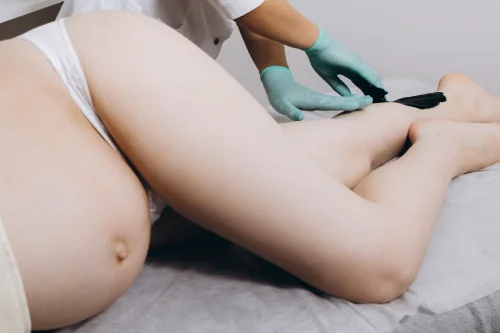Pregnancy should be an exciting and joyful time for any expecting mother. But it can also a time of major change, bringing hundreds of questions about the health, safety, and comfort of you and your baby. With so many new factors to consider, it’s great to know that you don’t have to compromise on your beauty routine. Although there are some methods you may need to avoid, with a little extra care, there’s bound to be hair removal technique that will keep you feeling smooth and sleek during the next nine months.

Why do women experience more hair growth during pregnancy?
During pregnancy, your body will go through many changes to accommodate your new baby. It is common for pregnant women to report the appearance of thicker hair, as well as hair growing in new and unexpected places, such as the face, chest, and stomach. No matter how alarming, the first thing to know is that this is perfectly normal! This new hair is caused by all the hormonal changes, as well as increased blood flow and metabolism, that occur during pregnancy. The good news is that there are a number of hair removal options to keep you feeling just as groomed during this time too. And the best news? For most women, these changes are temporary and the extra hair will disappear within six months of giving birth.

What types of hair removal are safe during pregnancy?
Tweezing, shaving, waxing, and depilatory creams are all suitable options for hair removal during pregnancy, as long as the warnings and directions for use on the products you choose are followed. It is recommended that before waxing or using depilatory creams you seek medical advice.
It is best to avoid laser hair removal and electrolysis during pregnancy, because it is not known whether these methods are safe for pregnant women.3 Talk to your doctor if you want more information on hair removal during pregnancy.

What is the best way to tackle hair removal when pregnant?
The best hair removal method during pregnancy may be different for each woman and may change with different stages of pregnancy. Your skin may be more sensitive and easily irritated, and you may need to change your usual hair removal method.4 Your growing belly may make it difficult to reach, or even see, some body parts—consider enlisting help from your partner or treating yourself to a salon visit.
Keep in mind that your skin may change during pregnancy making it unable to be waxed. If you develop any of the following skin conditions, you should avoid waxing the affected area:
- Varicose veins
- Spider veins
- Acne
- Rashes
- Scar tissue
- A dark line that runs from the navel to the pubic hair (linea nigra)
- Brown patches on the face around the cheeks, nose, and forehead (melasma).
Waxing may be suitable for pregnant women, but may cause some bruising. Talk to your doctor if you have concerns about waxing during pregnancy.
How to Remove Unwanted Hair During Pregnancy
Tweezing
The appearance of unwanted hairs around the upper lip, eyebrows, and nipples is common during pregnancy. For these niggling stand-alone hairs, plucking or tweezing is a great option for quick and precise hair removal. This method also avoids contact with products or chemicals that could irritate particularly sensitive areas such as the nipples.

Shaving
Shaving is a fast and effect method of hair removal, particularly on large areas such as the legs. However, the results of shaving are short-lived, and with increased growth of body hair during pregnancy, you may have to repeat your shaving routine more often.
How to shave safely:
- Make sure your chosen razor is sharp and clean.
- Clean the area you’d like to shave with water and/or soap and cover it in shaving cream.
- Wet the razor head and gently move it across your skin and shaving cream in the same direction as the hair.
- Rinse the razor and repeat until you’ve shaved the entire area, making sure you rinse after each stroke.
- Apply a fragrance-free moisturiser to minimise skin dryness after shaving.
Waxing
Waxing is a good option if you are looking for a more long-term solution—after all, you have enough things to be getting busy with between baby showers and baby names! Ideal for legs, underarms, and bikini lines, waxing can be done in the comfort of your own home, and has long-lasting results. Try Veet’s® range of wax for sensitive skin.

How to wax safely:
- Clean the area you are going to wax with water and soap, and dry the area completely.
- Apply warm wax followed by a wax strip, or a pre-waxed waxing strip to the area, and press down firmly as per the instructions for use.
- Hold your skin down with one hand, and firmly but gently use the other to pull the wax strip away from the skin in the opposite direction to the hair growth.
- Repeat until all of the unwanted hair has been removed, taking care not to wax the same area repeatedly.
- Remove any wax residue with a finishing wipe provided with the waxing kit or baby oil.
Depilatory Creams
Depilatory creams are another great option for legs, underarms, and bikini lines, especially if you are looking to avoid the ouch-factor of waxing. While these creams are considered appropriate to use during pregnancy (provided the warnings and directions for use are followed), they may cause irritation if your skin is extra sensitive. Try Veet’s® range of hair removal creams specially designed for sensitive skin, and always remember to test a small area of your skin before every use. Remember, consult a doctor first if you have exceptionally sensitive skin or other skin conditions.
How to use depilatory creams safely:
- Spread the cream evenly onto dry skin making sure the hair to be removed is fully coated.
- Leave the cream on your skin for the recommended time, as per instructions for use.
- Remove a small area of the cream – if the hair comes away easily, remove the rest of the cream. If your hair is more stubborn, leave the cream on for slightly longer making sure you don’t go over the maximum recommended time.
- Remove all the cream by rinsing it off with water, then dry your skin.
There is no one-size-fits-all when it comes to any aspect of pregnancy, but it’s safe to say that most women still want to look and feel their best during these happy months. Remember that changes to your body hair are very common, and there are many hair removal options you can try. Last but not least, always check with your doctor if you have any particular concerns about your body changes during pregnancy.
RB-M-106643
REFERENCES
- The American College of Obstetricians and Gynecologists. Skin conditions during pregnancy [Internet]. Washington DC; 2018 October [cited 2020 September]; [about 4 screens]. Available from: https://www.acog.org/womens-health/faqs/Skin-Conditions-During-Pregnancy.
- Tunzi M, Gray GR. Common skin conditions during pregnancy. Am Fam Physician. 2007 Jan; 75(2):211-18.
- Trivedi MK, Kroumpouzos G, Murase JE. A review of the safety of cosmetic procedures during pregnancy and lactation. Int J Womens Dermatol. 2017 Feb; 3(1):6-10.
- The Royal Women’s Hospital. Coping with common discomforts of pregnancy [Internet]. Victoria; 2018 April [cited 2020 October]; [about 4 screens]. Available from: https://thewomens.r.worldssl.net/images/uploads/fact-sheets/Common-discomforts-pregnancy-2018.pdf
- Shapiro J, Lui H. Treatments for unwanted facial hair. Skin Therapy Lett. 2005 Dec; 10(10):1-4.
- DermNet NZ. Shaving [Internet]. NZ; 2013 [cited 2020 Sept.];[about 2 screens]. https://dermnetnz.org/topics/shaving/.
- Veet® Easy-Gel™ Legs Wax Strips for Sensitive Skin Product Label
- Bozzo P, Chua-Gocheco A, Einarson A. Safety of skin care products during pregnancy. Can Fam Physician. 2011 June; 57(6):665-67.
- Veet® Hair Removal Cream for Sensitive Skin Product Label